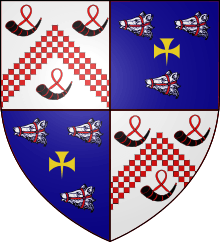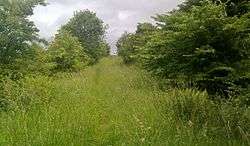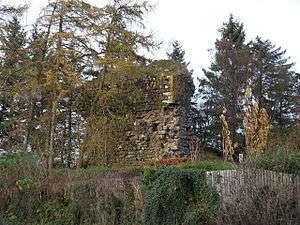Lands of Elliston
| Lands of Elliston | |
|---|---|
|
Howwood, Renfrewshire, Scotland UK grid reference NS | |
|
The remains of Elliston Castle | |
 Lands of Elliston | |
| Coordinates | NS 392598 |
| Type | Tower Castle |
| Site information | |
| Owner | Private |
| Open to the public | No |
| Condition | Ruined |
| Site history | |
| Built | 15th century[1] |
| Built by | Sempill family[1] |
| Materials | Stone |
The lands of Elliston, previously Elliotston[1] or Eliotstoun[2] or Elliestoun[3] in the Parish of Lochwinnoch were part of the holdings of the Barony of Elliston, later a part of the Castle Semple barony and estates. The ruins of the castle lie a short distance from Howwood in Renfrewshire in a private garden on a minor road between the A737 and the B776. The name may have derived from earlier holders of the lands, however the Sempill family held them since at least 1220. The castle was abandoned circa 1550 when John Sempill, 1st Lord Sempill moved to a new castle at Castleton which he renamed Castle Semple (NS 377602).[1]
The History of the Lands of Elliston
In 1540 the lands of ''Castleton, Eliotstoun, Schutirflat, Nethir-Pennell, Hairstontoun, Lavane, Bargane and Lecheland'' were incorporated into the new Barony of Semple, together with other lands in Lanark and Ayr. The new barony was held by William, Lord Sempill and the principal dwelling or messuage was Castle Semple.[4] Most of the lands within the parish of Lochwinnoch were once held by the Semples of Elliston.[5]
In 1505 James IV of Scotland visited John Sempill's at Elliston his collegiate church at Castle Semple to which he gave an offering of 14 shillings.[6]
The Lairds
The family have a number of recorded variations in their surname, including Sempill, Semphill, Sempil, Sempel and Semple. In about 1220 Robert Sempill, seneschal to the Barony of Renfrew,[7] held 'Elziotstoun' from the high-steward of Scotland and sometime prior to 1309, a Robert Sempill of 'Elziotstoun' is recorded.[8] Sir William Sempill in 1474 held the baronies of Elliston and Castleton, as did John, the first Lord Sempill in 1505.[2] In 1513, John, the first Lord Sempill, was killed at the Battle of Flodden.[1] In 1727 Hugh Sempill, 12th Lord Sempill, sold these lands to Colonel William McDowall of Garthland in whose family the lands remained until 1818, at which point John Harvey, Esquire, of Jamaica purchased the estate.[4]
The Sempills of Elliston were Hereditary Sheriffs of Renfrewshire and also Hereditary Baillies of Paisley. The family's arms were Argent, a chevron chequy Gules and Argent between three hunting horns Sable stringed Gules.[9]
Elliston Castle

Elliston Castle or tower[10] was a late medieval tower house with an attached courtyard which was probably abandoned after the Sempills moved to Castle Semple,[3] the new site previously being called Castleton, lying in the barony of that name. In 1735 the old castle was partly demolished.[11] In 1905 the old castle is recorded as still standing, but in exceedingly ruinous condition.[5] Further demolition took place in 1950 due to the dangerous condition of the castle.[3]
Elliston Castle measured 42 ft by 33 ft, with end walls around 9 ft thick and side walls around 6 ft thick. Built before the regular use of canons, gun-ports have been discovered in the walls. The walls were still 20 ft to 30 ft high in 1836, however by 1856 the north and south walls stood only stood at that height. Low courtyard walls of a rectangular shape were present in 1856. The castle's tower was rectangular, built with rough coursed masonry.[12] A vaulted basement existed and in the thickened south-eastern wall a stairway and mural chamber may have existed. The end walls probably had opposing arched windows.[3]
Elliston Bridge stands nearby, below the old Elliston Sawmill which was served by a leat with a sluice located at Linnister Farm on the Elliston Burn. Howwood Parish Church was once known as Elliston Chapel.[13]
Communications


The tower of Elliston guarded the important land route to the south at a time when no road existed closer to Lochwinnoch. This route was the Beith to Paisley Road as clearly marked on Roy's 1747 map that ran up from Beith, ran near Beltree farm passed Earlston Farm and the demolished Ward House through the Linnister Glen and the ruined Linnister Farm to cross the Elliston Burn. The old road continued up the valley side to run past the castle, then across the neighbouring fields before entering via Low Howwood along the remaining section of the road that then runs passed Glenfall House (Aitkins whinstone Quarry site), originally continuing on to George Street across land now built on; George Street has therefore become a cul-de-sac.[14]
Literature
The author Louise Turner has written a historical novel 'Fire and Sword' involving Sir John Sempill of Ellestoun, son of Sir Thomas, the Sheriff of Renfrew who died along with King James III at the Battle of Sauchieburn in 1488.[15]
See also
References
Notes;
- 1 2 3 4 5 Coventry, Page 521
- 1 2 Metcalfe, Page 422
- 1 2 3 4 Mason, Page 131
- 1 2 Metcalfe, Page 423
- 1 2 Metcalfe, Page 425
- ↑ Accounts of the Lord High Treasurer of Scotland, vol.3 (1901), p.xviii, 62
- ↑ Mason, Page 132
- ↑ Gazetteers of Scotland Retrieved : 2013-07-06
- ↑ The Heraldry Society of Scotland Retrieved : 2013-07-06
- ↑ Roy's Map Retrieved : 2013-07-06
- ↑ Scottish Castles Association Retrieved : 2013-07-06
- ↑ RCAHMS Retrieved : 2013-07-06
- ↑ Howwood - Renfrewshire Council Retrieved : 2013-07-06
- ↑ William Roy's Map Retrieved : 2013-07-07
- ↑ Turner
Sources;
- Coventry, Martin (2010). Castles of the Clans. Musselburgh : Goblinshead. ISBN 1-899874-36-4.
- Mason, Gordon W. (2013). The Castles of Glasgow And The Clyde. Musselburgh : Goblinshead. ISBN 9781899874590.
- Metcalfe, William H. (1905). A History of the County of Renfrew. Paisley : Alexander Gardner.
- Turner, Louise (2013). Fire and Sword. Hadley Rile Books. ISBN 978-0-9892631-3-9.
External links
| Wikimedia Commons has media related to Elliston Castle. |
